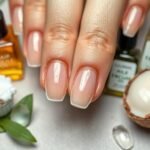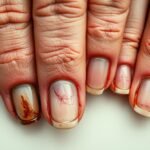Ever seen your fingernails look like an upside-down spoon? This is called nail clubbing. It might signal serious health issues, like lung cancer or heart problems.
Nail clubbing affects about 1% of people in internal medicine wards. It makes nails wider and spongy, curving downward. Fingertips also swell. These changes can happen fast, sometimes in weeks, and may go away if the cause is treated.
Most cases of clubbing are not hereditary. But, about 3% are. The rest, or secondary clubbing, is caused by diseases like lung cancer. Heart diseases, endocrine disorders, and gastrointestinal issues also play a role.
Knowing about clubbing nails is key to spotting health problems early. Let’s explore this condition further and its impact on your health.
Key Takeaways
- Nail clubbing affects 1% of internal medicine admissions
- Secondary clubbing is linked to lung cancer in 90% of cases
- Clubbing can develop within weeks or over years
- Primary clubbing is hereditary and rare, accounting for 3% of cases
- Diagnosis involves physical exams, medical history, and various tests
- Treatment focuses on addressing the underlying condition
Understanding Nail Clubbing: Definition and Characteristics
Nail clubbing is a fingernail issue where soft tissue swells around the nail beds. It changes the shape and look of your fingertips. This condition is linked to many health problems, so it’s important to notice its signs.
The Lovibond Angle: A Key Indicator
The Lovibond angle is a key sign of nail clubbing. It’s the angle between the nail bed and the nail plate. In healthy nails, this angle is less than 180 degrees. But in clubbing, it’s more than 180 degrees, making fingertips look more rounded.
Other Physical Signs of Clubbing
There are other signs that can help spot nail clubbing:
- Hyponychial angle: A normal angle is less than 192 degrees
- Phalangeal depth ratio: A ratio greater than 1 indicates clubbing
- Schamroth sign: The disappearance of the diamond-shaped window when opposing fingertips are pressed together
How Quickly Can Clubbing Develop?
Nail clubbing can appear fast, sometimes in just two weeks. This quick development often shows how fast underlying conditions can progress. But, with the right treatment, clubbing can also reverse quickly. This shows how well our bodies can heal.
| Aspect | Normal Nail | Clubbed Nail |
|---|---|---|
| Lovibond Angle | > 180 degrees | |
| Hyponychial Angle | > 192 degrees | |
| Phalangeal Depth Ratio | > 1 |
What Are Clubbing Nails: Common Causes and Associated Conditions

Nail clubbing is a sign of health issues. A study in Belgium found 1% of patients had clubbed nails. Of these, 40% had serious medical conditions.
Respiratory diseases are a top cause. Lung cancer is the most common in adults. Other respiratory issues include:
- Cystic fibrosis
- Tuberculosis
- Asbestosis
- Interstitial lung disease
- Chronic lung infections
Cardiovascular diseases also cause clubbing. This includes congenital heart defects and bacterial endocarditis. These conditions lower blood oxygen, leading to nail changes.
Other conditions linked to clubbing include:
- Celiac disease
- Liver disease
- Inflammatory bowel disease
- Thyroid disorders
In some cases, clubbing has no known cause. Genetic factors play a role in primary hypertrophic osteoarthropathy. This is a form of clubbing without lung disease signs.
Early diagnosis is key. Treating the underlying condition can reverse clubbing. Always see a doctor if your nails or fingertips change.
Pathophysiology of Nail Clubbing
Nail clubbing is a complex fingernail abnormality with several underlying mechanisms. Understanding its pathophysiology can help you recognize early signs and seek timely medical attention.
The Role of Growth Factors
Growth factors play a crucial role in the development of nail clubbing. Platelet-derived growth factor (PDGF) and vascular endothelial growth factor (VEGF) are released from peripheral megakaryocytes. These factors lead to increased vascularity, permeability, and changes in connective tissue.
Hypoxia and Its Impact on Clubbing
Hypoxia, or low oxygen levels, enhances the release of growth factors. This condition is often associated with various diseases that cause nail clubbing. In patients with cyanotic congenital heart disease, hypoxia contributes to the development of clubbing and hypertrophic osteoarthropathy.
Blood Flow Changes in Clubbed Nails
Blood flow alterations are significant in the formation of clubbed nails. Shunting of blood past capillary beds in the lungs or liver may contribute to this condition. These changes result in increased capillary density and tissue growth at the nail bed.
| Factor | Role in Nail Clubbing |
|---|---|
| Growth Factors (PDGF, VEGF) | Increase vascularity and tissue changes |
| Hypoxia | Enhances growth factor release |
| Blood Flow Changes | Increase capillary density at nail bed |
Early detection of nail clubbing is crucial as it can indicate serious underlying conditions. If you notice changes in your fingernails, consult a healthcare professional for proper evaluation and diagnosis.
Diagnosis and Evaluation of Nail Clubbing

Nail clubbing is a fingernail issue that needs careful checking. Your doctor will examine your nails and fingers closely. They look for signs like curved nails and swollen nail beds.
The Schamroth window test is a key tool. It involves pressing your index fingers’ nails together. If a diamond-shaped space disappears, it could mean clubbing.
- Lovibond angle: The angle between the nail plate and the nail fold
- Hyponychial angle: The angle between the nail bed and the finger pad
- Phalangeal depth ratio: The ratio of fingertip depth to interphalangeal depth
If clubbing is found, more tests will follow. These might include chest X-rays or CT scans. They help find problems in the lungs or heart, which often cause clubbing.
Remember, clubbing often points to a bigger health issue. If your nails change, get medical help right away. Finding and treating the cause early can greatly improve your health.
Conclusion
Nail clubbing is a sign that can point to serious health issues. Knowing what causes clubbing nails is key to catching problems early. Lung cancer, often linked to smoking, is a major cause.
Quitting smoking can cut lung cancer risk by 39% in five years. But, even after quitting, the risk stays high for years.
Nail clubbing is linked to many diseases that affect the body in different ways. It usually happens on both sides but can be one-sided in some cases. Growth factors like VEGF and PDGF play a role, often due to low oxygen or too many platelets.
Spotting nail changes early can help catch and treat diseases sooner. If your nails look different, see a doctor. They can figure out why your nails are clubbing and suggest the right tests or treatments. This could greatly improve your health in the long run.
FAQ
What is nail clubbing?
What are the common symptoms of nail clubbing?
How quickly can nail clubbing develop?
What conditions can cause nail clubbing?
What is the pathophysiology behind nail clubbing?
How is nail clubbing diagnosed?
Source Links
- Clubbed Fingers as a Sign of Lung Disease – https://www.verywellhealth.com/clubbing-of-fingers-914776
- Clubbed Fingers and Thumbs: What Causes Them? – https://www.webmd.com/a-to-z-guides/clubbed-fingers-and-thumbs-causes
- Why Do Fingers or Toes Become Clubbed? – https://www.healthline.com/health/clubbing-of-the-fingers-or-toes
- Clubbing of the fingers or toes Information | Mount Sinai – https://www.mountsinai.org/health-library/symptoms/clubbing-of-the-fingers-or-toes
- Nail Clubbing – StatPearls – NCBI Bookshelf – https://www.ncbi.nlm.nih.gov/books/NBK539713/
- Nail clubbing – https://en.wikipedia.org/wiki/Nail_clubbing
- Clubbed fingers: Causes, symptoms, treatment, and when to seek help – https://www.medicalnewstoday.com/articles/clubbed-fingers
- What Is Nail Clubbing? – GoodRx – https://www.goodrx.com/health-topic/dermatology/nail-clubbing
- Clubbing of the Nails: Practice Essentials, Background, Pathophysiology – https://emedicine.medscape.com/article/1105946-overview
- Clubbing – Clinical Methods – NCBI Bookshelf – https://www.ncbi.nlm.nih.gov/books/NBK366/
- Evaluation of clubbing – Differential diagnosis of symptoms – https://bestpractice.bmj.com/topics/en-us/623
- Clubbing: Bedside Evaluation for Associated Conditions – https://www.aafp.org/pubs/afp/issues/2002/0501/p1907a.html
- This Change In Your Fingernails Could Be A Sign Of Lung Cancer – https://www.ksby.com/fingernail-clubbing-could-signal-lung-cancer/








Interesting article but seriously, arent we overmedicalising simple things? Maybe an odd nail shape is just genetics, not a health issue. Chill, folks!
Interesting article, but honestly, isnt the Lovibond angle just a fancy way to scare hypochondriacs? Bit overhyped, dont you think?